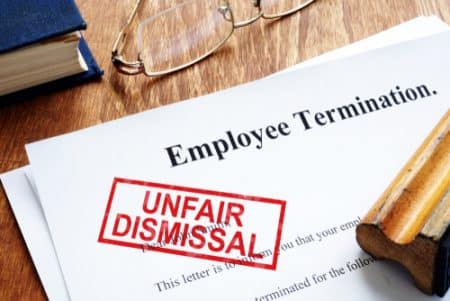You may have heard the phrase “wrongful termination” in a variety of contexts. However, only some sorts of termination are considered “wrongful” by the law. Wrongful termination necessitates that you were fired for an illegal purpose. Illegal reasons could include, for example, a violation of antidiscrimination legislation, a violation of whistleblower laws, or a breach of contract. If your termination was not the consequence of a legal or contractual infraction, you are most likely employed at will and may not have legal recourse for unfair termination. Read on for more information on at-will employment, wrongful termination lawsuit, and how an attorney can help you.
What Is Wrongful Termination?
When an employee is fired illegally, this is referred to as wrongful termination. This occurs when an employee is terminated due to workplace discrimination, when a corporation violates public policy in the process of terminating the employee, or when a company’s own termination rules are not followed.
There are also other causes, such as getting fired for blowing the whistle on your business and reporting issues such as a lack of workplace safety or unlawful conduct in which your employer is involved.
Wrongful Termination and At-Will Employment
In general, an at-will employment relationship means that either the employer or the employee has the right to discontinue the relationship at any time, with or without notice, and for any reason (or no reason at all). Except for Montana, all employment arrangements are believed to be “at-will.” At-will employment appears to allow at-will employers the authority to fire employees. However, “wrongful termination” is a significant exception to the at-will employment rule.
Exceptions to At-Will Employment for Wrongful Termination
Terminations that contradict a state’s public policy, terminations after an implied contract for employment has been established, and terminations in breach of the implied obligation of good faith and fair dealing are all examples of common law wrongful termination. Wrongful termination also covers terminations in violation of anti-discrimination statutes at the federal, state, or local levels. Each common law wrongful termination exception to at-will employment is described here.
#1. Exception in Public Policy
An employee is unlawfully fired under the public-policy exemption to employment at will when the termination violates a state’s unambiguous, well-established public policy. In most places, for example, a company cannot fire an employee for submitting a workers’ compensation claim after being injured on the job, or for refusing to engage in criminal activity at the employer’s request.
A state constitution, legislation, administrative regulation, or other state policy may contain public policy. The most widely acknowledged exception is the public-policy exception, which is recognized in the vast majority of states.
#2. Exception to Implied Contract
The second common-law exemption to at-will employment applies where an implied contract is formed between an employer and an employee despite the absence of an express, a written contract regarding the employment. An employer may make oral or written assurances to employees about job security or the procedures that will be followed when disciplinary action is taken. These representations may result in an employment contract. More than half of the states recognize the implied contract exception.
Absent a waiver that the policies in such handbooks do not generate contract rights, the contents and representations stated in employee handbooks can create an implied contract. The most typical example is a handbook clause stating that before punishing or firing an employee, an employer will follow particular procedures.
#3. Exception to the Covenant of Good Faith
This exception, which is recognized in a small number of jurisdictions, including California, incorporates a covenant of good faith and fair dealing into every employment agreement. This exemption indicates that either employer personnel decisions must adhere to a “just cause” standard, or terminations in bad faith or motivated by malice are forbidden.
A court considers factors such as whether the company followed its stated personnel policies, the length of the employee’s employment, any job security representations made, the presence or absence of prior criticism of performance, and basic notions of fairness in determining whether such a covenant is to be inferred.
What are the Illegal Justifications for Terminating an Employee?
An employer can fire an employee for a variety of illegal reasons. Among them are the following:
- Pregnancy
- Medical problems
- Information pertaining to genetics
- Relationship status
- Religion
- Race, ethnicity, and national origin
- The employee is over the age of 40.
- Status as a military or veteran
- Gender, sex, gender identity, gender expression, and sexual orientation are all terms that can be used.
- Disabilities, either physical or mental
Wrongful Termination: Was Your Termination Illegal?
How can you determine if your job termination was legal or illegal (referred to as “wrongful termination”)? The majority of jobs are “at will,” which means that an employee can be fired at any moment and for any reason, or for no reason at all (as long as the reason is not illegal). However, there are several significant exceptions to the at-will rule—as well as legal remedies—that may allow you to keep your employment or challenge your former employer for wrongful termination.
#1. Written Promises
You have a good case that you are not an at-will employee if you have a written contract or other documents that promises you employment stability. For example, you may have an employment contract that states that you can be fired only for good reasons or for reasons specified in the contract. Alternatively, you may have an offer letter or other written document that contains promises regarding your future work. If this is the case, you may be able to enforce such promises in court.
#2. Implied Promises
Another exception to the at-will rule is the existence of an implied employment contract—an agreement based on what your employer said and did. This can be difficult to show because most firms are wary of making promises of future employment. However, implied contracts have been discovered in situations where employers promised “permanent employment” or employment for a particular amount of time, or where employers set forth specific types of progressive discipline in an employee manual.
Courts consider a variety of factors when determining whether an implied employment contract exists, including:
- the length of your job
- frequency of job promotions
- a track record of favourable performance evaluations
- guarantees that you would have a job for the rest of your life
- whether your employer’s firing of you violated a common employment practice, such as failing to provide a required warning, or
- Whether long-term employment promises were made when you were hired
#3. Breach of Good Faith and Fair Dealing
If your employer acts unjustly, you may be able to sue for breach of a duty of good faith and fair dealing. Employers have been held to have violated the obligation of good faith and fair dealing by:
- Employees are fired or transferred to prevent them from obtaining sales commissions.
- Employees are being misled about their opportunities for advancement and compensation increases.
- Fabricating justifications for firing an employee when the true goal is to replace that employee with someone who will work for less pay.
- soft-pedaling the negative aspects of a profession, such as the have to travel through dangerous districts late at night, and
- Transferring an employee to remote, dangerous, or otherwise undesirable assignments on a regular basis in order to pressure the employee into departing without receiving severance pay or other benefits that might otherwise be due.
Some courts do not recognize the exception to at-will employment based on “good faith and fair dealing.” Furthermore, some states require the existence of a formal employment contract before employees can claim for a breach of good faith and fair dealing.
#4. Public Policy Violations
When firing a worker, it is criminal to violate public policy—that is, to terminate for reasons that society regards as invalid grounds for termination.
Most courts require that there be a specific law setting forth the policy before allowing a wrongful termination claim based on a violation of public policy. Many state and federal laws have specifically prohibited employment-related actions that obviously contradict public policy, such as firing an employee for:
- revealing a company practice of refusing to pay earned commissions and accrued vacation compensation to workers
- taking a leave of absence from work to serve on a jury
- taking time away from work to vote
- serving in the armed forces or the National Guard, or
- informing authorities of any wrongdoing that is harmful to the public (whistle-blowing).
Employees in some states are additionally protected from being dismissed for very particular reasons, such as serving as an election officer or a volunteer fireman. Some courts have also ruled that employers cannot terminate you simply because you used a legal remedy or exercised a legal privilege, such as submitting a workers’ compensation claim or reporting an Occupational Safety and Health Act infringement (OSHA).
#5. Discrimination
Employers are not permitted to fire even at-will employees for improper grounds, and discrimination is prohibited. If you suspect you were fired because of your race, color, national origin, gender, religion, age, handicap, pregnancy, or genetic information, you should consult with a wrongful termination attorney immediately. There are rigorous time constraints and rules that apply to discrimination claims; for example, before you may sue your employer in court, you must submit a complaint of discrimination with a state or federal body.
#6. Retaliation
Employers are prohibited from retaliating against employees who participate in legally protected activities. To demonstrate that you lost your job as a result of retaliation by your employer, you must demonstrate the following:
You were participating in a legally protected activity, such as filing a complaint with the Equal Employment Opportunity Commission or formally complaining to your employer about harassment or discrimination.
That actions compelled your employer to take action—for example, you were punished shortly after your employer learned that you had submitted a sexual harassment complaint.
Your employer’s action has a negative impact on you, such as being fired, denied a promotion, or receiving an unjustified poor performance rating.
#7. Fraud
In extreme situations, an employer’s methods while terminating a worker are so deceptive and wrong that they qualify as fraud. Fraud is frequently encountered throughout the recruiting process (when promises are made and broken) or during the last phases of employment (such as when an employee is induced to resign).
To demonstrate that your job loss was caused by fraud, you must provide all of the following evidence:
- Your employer made a false statement.
- Someone in authority was aware of the misleading representation.
- Your boss attempted to deceive you (or tried to induce you to rely on the representation)
- You did, in fact, rely on the portrayal, and
- Your reliance on the portrayal affected you in some way.
The most difficult aspect of proving fraud is demonstrating that the employer acted improperly on purpose in an attempt to deceive you. This necessitates good documentation of how, when, to whom, and how the misleading representations were made.
#8. Defamation
A defamation lawsuit is intended to safeguard a person’s reputation and good standing in the community. To establish that defamation was a factor in your job loss, you must demonstrate that your previous employer made false and malicious remarks about you while terminating your employment or providing references, which affected your chances of getting a new job.
In order to claim for defamation, you must usually demonstrate that your former employer:
- made a false claim about you
- uttered the remark with venom (that is, knowing that it was false or with reckless disregard to its falsity)
- that statement was told or written to at least one other individual, and
- damaged you in some way by disseminating the statement—for example, by causing you to lose your employment or preventing a new employer from hiring you.
To win a defamation action, you must demonstrate that the harmful statements were more than just watercooler chatter. True defamation requires both factual and fraudulent information.
#9. Violations of Whistleblowing
Whistleblowing laws protect employees who reveal illegal or harmful acts to the public interest. Some states provide protection to whistleblowers who report that their employer violated any law, rule, or ordinance. Other states provide whistleblower protection to employees only when they disclose that their company violated a specific law, such as environmental regulations or labor laws.
Checklist for Wrongful Termination
- Were you compelled to resign as a result of sexual harassment or an unjust workplace?
- Were you dismissed because of your race?
- Was the termination because you filed a workers’ compensation claim?
- Were you fired because you took a family leave?
- Were you fired because you demanded unpaid wages?
How Do You Prove Wrongful Termination?
Each type of wrongful termination has its own set of factors that a plaintiff must demonstrate in court. The employee will be required to present proof of an employment relationship. They must demonstrate that an employment connection existed and that the employee was dismissed by the employer. Alternatively, the job was “constructively” ended.
Plaintiffs must prove extra criteria in these sorts of termination actions.
- Harassment allegations
- The employee must demonstrate that they were fired because they filed a harassment complaint.
- Claims of Discrimination
- The employee must demonstrate that they are a member of a protected class. The discrimination was the driving force behind their termination.
- Claims of Public Policy
- First, the employee must demonstrate that they were fired for one of the legally protected grounds, such as
- Refusing to break or violate a law
- Using one’s constitutional rights
- Reporting a violation of a statute or law for the benefit of the general public
- Performing a legislative or required obligation
- First, the employee must demonstrate that they were fired for one of the legally protected grounds, such as
- Contract Infringement Claims
- The employee must demonstrate that they worked as a contractor for their employer. They must provide evidence that their termination breached the terms of the contract.
- These claims include those based on a violation of business regulations or labor union conditions.
- If your contract specifies the reasons for your dismissal, your employer can only terminate you for those reasons.
What are the Penalties and Damages in cases of Wrongful Termination?
Many employees worry if it’s worth the time and effort to sue their former employers for wrongful termination. Too many people believe that the wrongful termination lawsuit will take too long and that they will end up losing money in the long run. To make this conclusion, it is usually worthwhile to speak with a wrongful termination attorney.
If the court rules that you were unlawfully terminated, you may be entitled to compensation. Most importantly, you may be able to reclaim your employment, recover back pay as well as future compensation, be awarded punitive damages, or even be promoted.
You may be able to bring your employer to justice with the assistance of an experienced wrongful termination attorney.
How Long Do I Have to Submit a Claim for Wrongful Termination?
Wrongful termination claims must be filed within the statute of limitations. A statute of limitations is the period of time a plaintiff has after suffering harm to launch a wrongful termination lawsuit. The nature of the claim frequently determines the statute of limitations. This may have an impact on your timetable if you had an employment contract with your company. The lawsuit of the statute of limitations begins on the day of the wrongful termination in almost all circumstances.
In most circumstances, the statute of limitations for filing a claim is 180 days from the date of termination. You would file a claim with the Texas Workforce Commission if you worked in Texas (TWC). In other cases, the limit is extended to 300 days after termination. This is why it is critical to act swiftly following your termination. Maintain as much documentation as feasible.
You can bring a wrongful termination lawsuit against your employer after filing a claim with the proper authorities. You have two years to file your wrongful termination lawsuit.
Common Misconceptions About Wrongful Termination among Employees
It can be aggravating for an employee to be fired for no apparent reason. In many circumstances, it may come down to a simple disagreement about how an employee perceives their own work talents against how an employer judges job success.
However, a termination is only “wrongful” if it is illegal in the legal sense. There are numerous myths and misconceptions about “wrongful termination.”
Here are the top seven wrongful termination fallacies that many employees believe.
Myth #1: Any termination that appears to be unreasonable constitutes wrongful termination.
You can be fired at any time if you were hired on an at-will basis in a state like California, where the prevalent legal principle is “employment at will.” The employer has the right to do so for any reason or no reason at all. As harsh as it may sound, your employer has the authority to terminate you for chewing gum or using your smartphone during working hours.
Unless an employment contract is formalized between you and your employer, you can be fired for almost any cause. If the employment contract specifies a reason for termination and the fired employee is not provided with one, he or she may make a claim for wrongful termination.
It is not true, however, that federal and state employment rules, including as anti-discrimination statutes, do not apply in at-will jurisdictions. If an employee is fired for illegal reasons, such as discrimination, the employer may face legal consequences.
Myth #2: I can be fired legally for openly revealing I voted for a specific candidate.
It makes no difference who you voted for in the presidential election. You have the right to express your political beliefs at work. However, this is only applicable if you work in one of four states: California, Connecticut, South Carolina, or Louisiana. These four states have laws that guarantee employees’ ability to openly express their political opinions.
Several other states provide individuals with legal protections for attending political rallies or endorsing candidates, but you’ll need to consult with an employment law attorney to determine whether your situation qualifies for a prospective wrongful termination lawsuit.
Myth #3: Discrimination rules exclusively apply to minorities and women in the workplace.
Every individual with a distinct gender, color, religion, natural origin, citizenship status, marital status, or medical history has the right to be protected by employment discrimination legislation. That pretty much covers everyone!
Anyone can face workplace discrimination, regardless of whether they are male or female or a member of a minority group.
As a result, anyone who is fired because of their color, disability, medical condition, religion, sexual orientation, or other factors may submit a wrongful termination claim.
Myth #4: It is impossible to prove that I was fired in reprisal for speaking out against an illegal workplace conduct.
It may be feasible to demonstrate that you were dismissed in retaliation for exposing illegal activities at work. For example, in July 2018, a former banker filed a wrongful termination lawsuit against Wells Fargo.
Whistleblowers are protected from reprisal under federal and state legislation in various states. Employers cannot penalize employees who report wrongdoings or unlawful actions within an organization.
Myth #5: I can’t sue my company if I quit.
It’s a prevalent misperception that if an employee resigns, they can’t sue for wrongful termination. There are times when an employee feels the workplace climate to be too unfriendly, unacceptable, or dangerous to continue working for a company. The only option left to them is to resign.
An employee can still sue his or her company in such instances. Even if the employee was coerced into resigning, they have the right to make a wrongful termination claim or file a lawsuit.
Myth #6: Employment law protects all employees over a certain age.
Workplace age discrimination is frequent. However, you may be mistaken if you believe that if you are over the age of 40, you are automatically covered under the Age Discrimination in Employment Act (ADEA) of 1967. The act exclusively covers job seekers and workers who meet certain criteria. Employees in this category include individuals who work for a private employer who employs 20 or more people for a minimum of 20 weeks per year.
If you are covered by the ADEA, you have the right to sue your employer for age discrimination in termination, hiring, appraisal, and privileges.
Myth #7: My employer will reach a rapid settlement because they value their reputation.
Do not expect your employer to settle quickly if your wrongful termination lawsuit is not based on facts or supported by reliable proof.
Lawyers engaged by huge corporations are unconcerned about public perception. Unless you are a prominent figure or celebrity, the incident is unlikely to be covered in local publications.
Settlements for Wrongful Termination
Employees who were unlawfully terminated may be able to reclaim their employment, back pay, compensatory damages, and other expenditures through a successful wrongful termination case. A wrongful termination lawsuit contend that an employee was fired in violation of state or federal law or in violation of an employment agreement. Wrongful termination cases can be difficult to establish, which is why many of them are settled. The value of a wrongful termination settlement is determined by a variety of criteria that differ from case to case.
Why Are Wrongful Termination Settlements So Popular?
The vast majority of wrongful termination claims are settled out of court. Instead, the majority of cases are settled before going to trial. Because of the unpredictability of jury trials, settlement is frequently the best option for all sides.
One of the most difficult challenges for the terminated employee is demonstrating persuasive proof that the employee was terminated for illegal reasons, such as their race, gender, whistleblowing, or reporting harassment. Employers frequently reply by providing documentation of ostensibly valid grounds for the firing, such as poor performance.
Employers frequently have good reasons for settling. In addition to the uncertainty of a trial, a wrongful termination lawsuit can uncover potentially damaging information about a corporation even when employers successfully defend themselves. Trials can also take a long time and be more expensive than settling.
How Much Are Wrongful Termination Claims Worth?
A wrongful termination claim’s monetary value is determined by numerous variables, including the amount of losses and damages experienced as a result of the firing. The following are common variables for determining the value of a claim:
- Wages have been lost.
- Benefits reduction
- Distressed emotions
- Damages for Wage Loss
#1. Wage Loss
Wage loss is the amount of pay, including bonuses and commissions, lost by the employee from the date of termination to the present. A plaintiff has an obligation to try to locate another work in order to reduce these damages. Any interim benefits, such as income from a new job or unemployment benefits, can be subtracted from the overall wage amount earned in the previous year. Future pay loss may also be considered if the employee has not found new employment by the time of trial or settlement.
#2. Benefits Reduction
When calculating lost wages, the loss of benefits is also taken into account. For example, if a discharged employee is required to pay for their own health insurance after termination, the employer may be held accountable for these out-of-pocket payments. Fringe benefits, such as the loss of stock options, can also be considered beneficial.
#3. Damages Caused by Emotional Distress
The price of emotional pain as a result of wrongful termination. Employees who have suffered from anxiety, sadness, or other emotional anguish as a result of their termination may claim restitution. Recovering for emotional distress is more likely in circumstances where the alleged actions were particularly egregious, such as harassment or discrimination claims.
Other Factors Influencing Settlements for Wrongful Termination
Some employees file claims that go beyond monetary compensation. A settlement agreement could include the reinstatement of the fired worker’s employment, a promotion, or a change in working circumstances.
When there is a discrimination culture in the workplace, some unfairly dismissed employees may seek justice, validation for their claim, and closure. A settlement agreement may include a demand for changes in corporate policy to prevent similar wrongdoing in the future.
There are other reasons why an employee or employer would refuse to settle their case. Some employers who believe they have done nothing wrong may want to delay settling in order to discourage future claims.
Obtain Legal Assistance With Your Wrongful Termination Attorney
If you believe your termination was wrongful, having an attorney on your side who is familiar with your state’s employment laws can be extremely beneficial in determining how to proceed. Their counsel can help you avoid costly mistakes and navigate the difficulties of negotiation and litigation.
What steps can an employee take to protect themselves from wrongful termination?
An employee can protect themselves from wrongful termination in a number of ways, including keeping records of any discrimination or harassment they experience, reporting any illegal activity to the appropriate authorities, and consulting with a wrongful termination attorney if necessary. Knowing their legal rights and being familiar with company policies and procedures are also important.
How much does it cost to hire a wrongful termination lawyer?
There are a number of variables that can affect the final price tag of a wrongful termination attorney’s services, including the nature of the case, the lawyer’s level of experience and reputation, and the geographical location of the dispute. A wrongful termination attorney can cost anywhere from several thousand to tens of thousands of dollars.
What are some common defenses to a wrongful termination claim?
Insufficient evidence, improper procedure, or lack of jurisdiction are often raised as defenses to claims of wrongful termination. Other possible justifications include the employee’s poor performance, insubordination, or violation of company policies.
What is the typical outcome of a wrongful termination case?
Depending on the specifics of the situation, a wrongful termination case’s typical outcome can swing wildly. A settlement or damage award may be reached in some cases, while others may be dismissed or decided in the employer’s favor.
How can a wrongful termination lawyer help an employee prove their case?
An attorney who specializes in wrongful termination cases can assist an employee in establishing their case by conducting investigation, drafting and filing paperwork, appearing in court on their behalf, and negotiating with their employer. An attorney specializing in employment law can advise their client on the best way forward and help them better understand their legal rights and options in the event of a wrongful termination.
What is the role of a wrongful termination lawyer?
A wrongful termination attorney’s job is to advocate for workers who have been wrongfully let go from their positions. A lawyer experienced in wrongful termination cases can advise an employee on their legal options, assist with the collection and evaluation of evidence, and draft and file any necessary paperwork. An attorney for wrongful termination can represent an employee in negotiations with the company and in court if necessary.
Wrongful Termination FAQs
Is it hard to prove wrongful termination?
This can be a challenging undertaking because employers and managers rarely acknowledge to having illegal motivations when firing you.
What qualifies as a wrongful termination?
Being wrongly terminated means being fired for an illegal reason, which could include a violation of federal anti-discrimination statutes or a breach of a contract. An employee, for example, cannot be fired because of her race, gender, ethnic heritage, religion, or disability.
Can I sue for being wrongfully terminated?
Yes, you can sue your company if you were unlawfully fired. People all too often desire to sue for being dismissed when the employer had a genuine basis to fire them. Not all shootings are illegal.
What is the average payout for wrongful termination?
In general, readers who filed a wrongful termination claim against a major firm (one with more than 100 employees) earned $43,400 in compensation—nearly twice as much as readers who worked for smaller employers. Large firms may just have the resources to provide greater pay packages.
- WRONGFUL TERMINATION CALIFORNIA: 7+ Wrongful Termination Ground In California
- LOS ANGELES WRONGFUL TERMINATION LAWYER: 13+ Top Rated Wrongful Termination Lawyers In Los Angeles
- EMPLOYMENT LAWYER: How and When to Hire an Employment Attorney
- EMPLOYMENT LAWYER DISCRIMINATION: Forms of Discrimination & All You Need To Know
- WORKPLACE LAWYER DISCRIMINATION: How Lawyers Assess Discrimination Cases & What They Can Do For You







